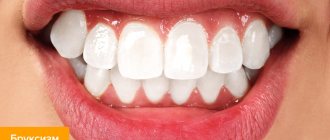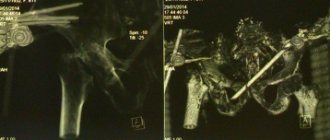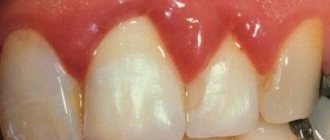Posted by Marbery Gedrean | Checked by: Shteba Victoria Petrovna | Last revised: June 05, 2022.
Periodontology is a field of dentistry that includes the prevention, diagnosis and treatment of diseases of the periodontal tissues and their pathologies, as well as maintaining the health, function and aesthetics of these structures. Simply put, the term periodontics refers to the treatment of the gums and bone around the teeth.
What is periodontics?
Periodontology is a branch of dentistry that deals with the treatment and prevention of periodontal diseases.
Periodontal diseases are widespread among the population. According to the World Health Organization in Russia, about 85% of the adult population and up to 65% of children have signs of periodontal disease. The particular danger of periodontal disease lies in the fact that the onset and first stages of the disease can be asymptomatic. The most common reasons for treatment in periodontology are gingivitis, periodontitis and periodontal disease.
The treatment, prevention and diagnosis of periodontal diseases is carried out by a periodontist. A periodontist is a dentist who has completed a special training course.
You need to consult a periodontist if you have the following symptoms:
- formation of plaque and tartar on teeth.
- bad breath;
- bleeding gums when brushing teeth;
- exposure of the neck of the teeth;
- mobility of teeth, change in their position;
What is periodontology and periodontology?
The tissues that are located around the subgingival part of the teeth are called periodontium. It has a multilayer structure: gums (mucous membrane covering the teeth in the cervical area); dental root cement; periodontium (tissue between the cementum and the socket); periosteum (tissue covering the bone) and alveolar process (part of the jaw tissue on which the dental units are located). These tissues securely hold the tooth in the socket (alveolus). The branch of dentistry that studies the periodontium, its functions and diseases is called periodontology.
What are the causes of periodontal disease?
It is worth highlighting local and general reasons. Local reasons include:
- poor oral hygiene;
- incorrectly installed crowns, fillings, dentures;
- gum injury from sharp edges of dentures and teeth;
- anomalies in the development of the frenulum of the tongue and lips;
- bad habits (sucking or biting the tongue, soft tissues of the oral cavity, other foreign objects);
- an unsanitized oral cavity, a significant number of teeth affected by caries, is a concentration of a complex of periodontal-damaging factors;
Common factors include:
- weakened immunity;
- smoking;
- diseases of the digestive tract;
- hormonal metabolism disorders (diabetes mellitus and other diseases);
- infectious diseases (hepatitis C, HIV, syphilis);
- blood diseases;
- side effects of medications (for example, antiepileptic drugs).
What types of gum diseases exist?
The main gum diseases include:
- Gingivitis;
- Periodontitis, periodontitis.
Gingivitis is a general term for diseases affecting the gums. Gingivitis is usually caused by bacterial plaque that accumulates in the spaces between the gums and teeth and in the tartar that forms on the teeth. These deposits may be tiny, even microscopic, but the bacteria in them produce foreign chemicals and toxins that cause inflammation of the gums around the teeth. This inflammation can cause more severe gum disease over the years and lead to bone loss around the teeth (a disease also known as periodontitis).
People with healthy periodontium (gums, bones and ligaments) or people with gingivitis require professional cleaning every 5-6 months. However, many dentists recommend periodontal cleanings every 3-4 months to maintain gum health.
If inflammation in the gums becomes severe enough, it can penetrate the gums and allow small amounts of bacteria and bacterial toxins to enter the bloodstream. The patient may not notice it, but research shows that it can lead to increased inflammation in the body and even cause heart problems.
The sudden onset of gingivitis in a normal, healthy person should be considered a warning of a possible viral etiology, although most systemically healthy people have gingivitis in some areas of the mouth, usually due to improper brushing.
Symptoms of gingivitis
- Swollen gums;
- Wounds;
- Bright red or purple gums;
- Shiny gums;
- Pain when pressing on the gum;
- Gums bleed easily (even with gentle brushing, especially flossing);
- Gums that itch with varying degrees of severity;
- Receding gum line;
Prevention
Gingivitis can be prevented with regular oral hygiene, which includes daily brushing and flossing. As well as preventive visits to the dentist and the use of professional comprehensive oral and dental hygiene.
Diagnostics
Like any disease, the main thing is to diagnose gingivitis in time and begin treatment. That is why it is recommended to regularly visit a dental hygienist to notice the first signs of gingivitis. You should immediately check for various symptoms of gingivitis and can also check the amount of plaque in your mouth. The dentist will also examine you for periodontitis using x-rays or probing of the gums, as well as other methods.
Treatment
Your dental hygienist will perform a thorough cleaning of your teeth and gums. After this, constant oral hygiene is necessary. Plaque removal is usually not painful, and gum inflammation should resolve within one to two weeks. Bacterial plaque from tartar from the root surface below the gum line is removed using curettage therapy. This procedure may also require the removal of infected tissue in the periodontal pocket of each tooth to stop further progression of the disease. Depending on the degree of gum inflammation and the depth of the periodontal pocket, a periodontist prescribes curettage using an open or closed method.
Oral hygiene, including proper brushing and flossing, is essential to prevent recurrences of gingivitis. Antibacterial rinses or mouthwashes, particularly chlorhexidium digluconate 0.2% solution, can reduce swelling, and topical mouth gels, which are usually antiseptic and anesthetic, can also help.
Possible complications:
- Recurrence of gingivitis;
- Periodontitis;
- Infection or abscess in the gums or jaw bones;
- Transfer of infection through the blood to other organs.
Why is plaque the main cause of periodontal disease?
Soft plaque is a sticky, colorless film that constantly forms on the teeth and contains a large number of bacteria. If soft plaque is not removed in time, it hardens and forms tartar. Bacteria found in tartar produce toxins (poisons) that irritate the gums, causing inflammation, bleeding and swelling. As the disease progresses, toxins can lead to periodontal destruction. Good personal hygiene and professional oral hygiene will help reduce the risk of gum disease. However, if no treatment is given, the affected teeth can eventually be lost.
Recommendations from prevention experts
- Regular and thorough oral hygiene twice a day
- Cleaning teeth after every meal (rinsing, flossing)
- Course use of special preventive toothpastes
- Complete balanced nutrition
- Compliance with all medical prescriptions for the treatment of diabetes and other serious diseases
- Maintaining immune status at the proper level
- Quitting smoking (reducing the number of cigarettes you smoke)
The network of dental clinics “Smile” offers periodontology services: treatment of gum inflammation. Contacting our centers has several significant advantages:
- We employ highly qualified specialists;
- we follow diagnostic and treatment protocols that meet international standards;
- We use a system of family and cumulative discounts;
- we guarantee a stable cost of treatment according to the approved price list.
You can contact any of the branches of our clinic in Moscow, located within walking distance from metro stations:
- Alekseevskaya (VDNKh district, etc. Mira), address: st. 3rd Mytishchiskaya house 3, building 2;
- Shelepikha, address: Shelepikhinskaya embankment, address: building 34, building 1.
Do not delay your visit to the periodontist; make an appointment as soon as the first symptoms appear. This will significantly shorten the duration of therapy and reduce costs. Our doctors will provide effective dental care regardless of the severity of the disease. We will take care of your health!
What is gingivitis?
Gingivitis is an inflammation of the gums caused by the adverse effects of local and general factors (it is the initial stage of periodontitis), which occurs without compromising the integrity of the periodontal attachment and the manifestation of destructive processes in other parts of the periodontium. The gums turn red, swell and begin to bleed slightly. Pain, swelling, and bad breath may occur. Usually the inflammation begins between the teeth. If the cause of the disease is not eliminated, then acute gingivitis becomes chronic, which does not go away on its own without treatment.
How Vector works
It is the use of the Vector device that is the gold standard of modern periodontology. It generates ultrasonic vibrations of a strictly defined frequency, under the influence of which tartar is separated from the surface of the enamel. The doctor runs a thin tip over the surface of the teeth, paying special attention to the cervical area. A water jet irrigating the tip of the device washes away deposits from under the gums. The procedure has a polishing effect. The surface of the teeth becomes smoother, which means plaque formation slows down. Treatment of gums in periodontology in Moscow today is impossible to imagine without Vector-therapy. Its effectiveness and safety are time-tested. Patients note positive dynamics after the first procedure: swelling, pain, and itching decrease. The gum tissue becomes evenly colored and denser. If you have any questions regarding treatment with the Vector device, you can contact our doctor during your initial consultation.
Advantages of Vector therapy
- The procedure does not harm tooth enamel;
- Allows you to completely remove microbial film from the tooth surface;
- Positive effect already 2-3 days after the procedure;
- Periodontal pockets are cleaned without curettage, without surgical intervention;
- No anesthesia is required and the procedure is well tolerated.
The procedure has a powerful healing effect. It has proven itself well and is used all over the world. The peculiarity of conservative periodontology is the repeated nature of the impact. If surgical intervention is performed once, then conservative methods usually require a course of use. Cleaning with the Vector device is usually carried out twice with an interval of 1 month.
Conservative treatment of periodontitis
Periodontitis today, along with caries, is one of the most common diseases of the oral cavity. It is an inflammatory process localized in the area of one or more teeth. The course of periodontitis is accompanied by the formation of periodontal pockets. Bacteria and food particles accumulate in them, which leads to swelling, soreness, suppuration and bad breath. Treatment tactics are selected individually, taking into account the root cause of the disease.
General treatment regimen
As a rule, conservative therapy includes the following steps:
Stage 1
– elimination of common factors that provoke gum disease:
- Training in oral hygiene rules. Maintaining hygiene during treatment and subsequent remission is of paramount importance.
- Professional oral hygiene. Cleaning helps remove plaque and hard deposits. This contributes to the creation of an apathogenic environment in the oral cavity.
- Treatment of caries. It must be carried out without fail to eliminate foci of proliferation of pathogenic bacteria.
During the examination, the doctor can identify what was the root cause of the development of periodontal disease. In some cases, this may be an incorrect bite or poorly selected orthopedic structures. In this regard, the patient is referred for consultation to a specialized specialist: an orthodontist or an orthopedist. Elimination of the factor that became the trigger leads to a significant improvement in the condition of the oral cavity.
Stage 2 – elimination of the inflammatory process in the gum tissue
After professional oral hygiene or Vector therapy, the gums are treated with antiseptic agents. The doctor also prescribes ointments, elixirs, oral baths, mouth rinses, antiseptics, etc. for home use. The choice of medications is carried out according to indications on an individual basis.
Stage 3 – elimination of periodontal pockets
If conservative methods fail to stop the inflammatory process, curettage of periodontal pockets is performed. The procedure can be performed open or closed. The doctor completely cleans the pocket of pathogenic microorganisms, dead epithelial cells, food particles, and deposits. The surface of the root is polished, the pocket is washed with antiseptic compounds. Don't be afraid of curettage. The intervention is performed locally using anesthesia. The tissues of the gums and oral mucosa regenerate very quickly, so the healing process does not take much time. The doctor will set a date for a follow-up examination to evaluate the results of the curettage and decide on a further plan of action.
Stage 4 – recovery period
During the recovery period, it is very important to follow the recommendations of your doctor. First of all, this concerns the rules of oral hygiene. Also, you should avoid injuring the problem area. Do not eat too hot, spicy, or hard foods until the gum tissue has completely healed.
Stage 5 - clinical monitoring of the patient’s condition
Each patient who has been diagnosed with periodontitis must visit a doctor 2 times a year for monitoring and routine professional oral hygiene. Other problems that arise should be resolved in a timely manner: treat caries, carry out dental prosthetics if necessary. This set of measures will allow you to maintain the oral cavity in order and avoid relapse of the disease and associated inconveniences.
Splinting teeth
Another equally dangerous disease is periodontal disease. It is less common and is not inflammatory, but atrophic in nature. The bone tissue of the alveolar process of the jaw changes its structure, becomes looser, gradually collapses, and the height of the partitions between the teeth decreases. As a result, the teeth become mobile and fan out. To prevent their further loosening and create conditions for the restoration of the tissues surrounding the tooth, splinting is performed. To do this, use thin white fiberglass tape. On the unnoticeable surfaces of the teeth (lingual, chewing), a groove is formed into which the tape is placed. It allows you to reduce the range of tooth movements.
What is periodontitis?
Periodontitis is an inflammation of periodontal tissues, characterized by destruction of the periodontal ligaments and alveolar bone.
If treatment is not carried out in time, gingivitis turns into periodontitis. Periodontitis can be acute or chronic. In a chronic process, pain and swelling are mild. The amount of soft plaque and tartar increases, the bad breath increases, the gums begin to recede, exposing the neck of the tooth, and teeth become sensitive to temperature stimuli. Then, at first, imperceptible but quickly increasing tooth mobility appears. Suppuration of periodontal pockets is often observed.
What is periodontal disease?
Periodontal disease is a degenerative process that affects all periodontal structures. Its distinctive feature is the absence of inflammatory phenomena in the gingival margin and periodontal pockets. Bone tissue atrophy is painless, continuous and, if left untreated, leads to the complete disappearance of the ligamentous apparatus, the walls of the tooth sockets and their loss. The exact cause of the disease is still unknown. It is believed that the onset of the disease is associated with impaired blood circulation in periodontal tissues and endocrine disorders.
Relevance. Immunomodulation is becoming increasingly relevant in gerontodental practice, the purpose of which cannot be empirical and requires the study of relevant laboratory parameters. Studying the composition of gingival fluid allows us to evaluate not only the aging processes of the immune system and their impact on the clinical course of periodontitis, but also the effectiveness of the therapy. To evaluate the effectiveness of transcranial electrical stimulation (TES) in the treatment of periodontitis in elderly people, to substantiate the clinical and diagnostic value of laboratory parameters of gingival fluid during immunomodulatory therapy. Materials and methods. A clinical, prospective, controlled, randomized, unblinded, comparative study was conducted. Two clinical groups (68 people) of people aged 60-74 years suffering from periodontitis were examined. All patients received the same basic therapy. In group 2, TES was prescribed. An assessment was made of the dynamics of the level of IL-1β, TNF-α, IL-10, sIgA and LDH in the gingival fluid, as well as the reduction of periodontal indices: bleeding and PMA (in%) in the following periods: before treatment, on the 7th, 14th th, 21st and 30th days after the start of observations. Results. It was found that the complex treatment regimen for periodontitis, including TES (immunomodulation), has greater clinical effectiveness in comparison with traditional therapy (starting from the 14th day, there were statistically significant differences in clinical and laboratory parameters between groups 1 and 2 (p <0.05)). On the 30th day of observation, the described trends continued: gingival fluid levels in both groups continued to decline. Moreover, their values in group 2 were statistically significantly lower than in group 1 (IL-1β level (pg/ml) was: 16.90 ± 0.33 and 18.80 ± 0.38; TNF-α (pg/ml): 11.90 ± 0.37 and 14.4 ± 0.4; IL-10 (pg/ml): 11.00 ± 0.35 and 12.90 ± 0.36, respectively) ( p < 0.05). Conclusion. TES (as a component of complex treatment) has greater clinical effectiveness in comparison with the traditional treatment regimen for periodontitis in elderly patients. Of great importance in gerontodental practice is the laboratory analysis of the composition and properties of gingival fluid, as well as the selection of its most indicative immunological and biochemical components: IL-1β, TNF-α, IL-10, sIgA, LDH. This enables the periodontist not only to confirm the observed dynamics of clinical manifestations of periodontitis in the elderly, but also to verify the consistency of immunomodulation.
How is periodontal disease diagnosed?
Initially, a medical history (anamnesis) is carefully collected. Careful collection allows us to determine risk factors and predict the course of the disease. This is followed by an examination of the oral cavity. One of the main examination methods is probing the periodontal pocket of each tooth; here the latest technologies come to the aid of the doctor. Computer diagnostics using the Florida Probe device.
The Florida Probe system is a modern software and diagnostic complex that allows you to conduct an accurate study of the condition of the patient’s gums (periodontal) and record the results in the form of an electronic periodontogram.
The obtained accurate data is entered into an electronic periodontogram and, in combination with an x-ray examination, allows the doctor to make an accurate diagnosis and prescribe treatment, after which a repeat periodontogram can be drawn up and the achieved result can be assessed.
A mandatory diagnostic method is x-ray examination. Our center performs X-ray examinations using a Galileos computed tomograph.
Treatment methods for periodontal diseases in KGNY
- Professional hygiene (mechanical, ultrasonic teeth cleaning, Air-Flow soda jet polishing);
- Using the “Vector” device;
- Splinting and grinding of teeth to eliminate their overload;
- Replacement of low-quality and traumatic fillings and prostheses;
- Open and closed curettage - cleaning periodontal pockets;
- Surgical gum plastic surgery, laser correction of its edge;
- Replenishment of bone loss: stimulation of its growth using the Fibrine Riche en Plaquettes (FRP) method and replacement of its defect with bone grafting (bone graft);
- Physiotherapy (electrophoresis of drugs);
- Drug therapy (anti-inflammatory, immunostimulating, detoxification, hormonal, antibiotic therapy if necessary);
- Correction of nutrition, lifestyle, individual selection of hygienic oral care products.
If you experience symptoms of periodontal disease, contact our hospital dentists! We will carefully study your health condition and select the most effective therapy!
You can see prices for services
What is the treatment for periodontal disease?
For treatment to be effective, the patient must strictly follow all doctor’s instructions. Only in this case is it possible to stabilize periodontal disease for a long time. A variety of treatment regimens have the same goals and objectives. A comprehensive treatment plan consists of general and local treatment.
Local treatment includes:
- elimination of traumatic factors
- drug anti-inflammatory therapy
- conservative (non-surgical) therapy
- surgical operations
- orthodontic treatment
- prosthetics
- splinting
General treatment includes:
- treatment of concomitant diseases
- general strengthening measures
- balanced diet
Treatment begins with the elimination of traumatic factors: low-quality fillings, crowns with an overhanging edge, etc. are removed. The next stage of treatment is professional oral hygiene, which removes tartar located both above and below the gum.
Anti-inflammatory therapy. Drug treatment can relieve inflammation, swelling and reduce bleeding of the gums. The Vector Paro device is ideal for conservative treatment. When the Vector device is operating, a mixture containing tiny particles of hydroxyapatite is sent to the working instrument, with the help of which supragingival and subgingival dental deposits are effectively and efficiently removed, damaged gum tissue is cleaned, the number of bacteria and endotoxins in the affected tissues is reduced, and the increased sensitivity of teeth to temperature stimuli is reduced. after treatment.
Surgery. Periodontal surgical treatment is a radical method, but one of the most effective. With the help of minor operations, periodontal pockets can be eliminated, infected soft tissues can be removed, and bone tissue substitutes can be implanted.
Prosthetics and splinting. Prosthetics for missing teeth and permanent splinting of loose teeth are the final stage of treatment. If, after successful therapeutic and surgical treatment, rational prosthetics and splinting are not carried out, the disease may worsen again in the near future.
After completion of treatment, we recommend that you follow all doctor’s instructions. It is imperative to visit a periodontist 2 times a year for a follow-up examination and professional oral hygiene.
Methods for treating gum inflammation
Treatment of gum inflammation is a complex of therapeutic and (or) surgical measures aimed at eliminating the causes of inflammation and restoring periodontal functions.
Treatment is prescribed by a periodontist after a visual and hardware (if necessary) examination. The list of therapeutic measures depends on the factors that initiated the onset of the disease and the severity of the pathological process. Treatment methods for periodontal diseases:
- elimination of the causes that caused the pathology (for example, bite correction, replacement of dentures, stabilization of blood glucose levels, etc.);
- professional cleaning with an ultrasonic scaler and AirFlow device;
- applications and rinsing with antiseptic and medicinal preparations;
- administration of drugs by injection into the gingival surface;
- massage to strengthen gums;
- electrophoresis and other physiotherapy procedures;
- excision of gingival margins (for hypertrophied gingivitis);
- course of antibiotics and vitamins;
- treatment with the “Vector” device;
- laser treatment of periodontal pockets, in severe cases – curettage (surgical cleansing);
- splinting loose teeth;
- plastic surgery of gum recession;
- bone grafting.
Important: periodontists of the “Smile” network of clinics are proficient in modern methods of treating periodontal tissues; our centers are equipped with the latest equipment for diagnosing and treating gum inflammation. You can make an appointment for a consultation by phone or by using the “Book online” or “Request a call” options on our website.






